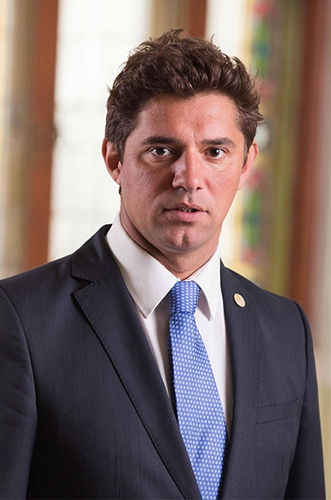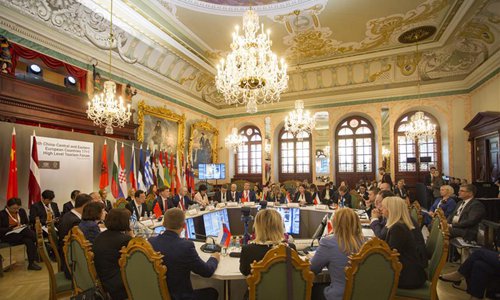Participants attend the 5th China-Central and Eastern European Countries (CEEC) 17+1 High-level Tourism Forum in Riga, Latvia, on Oct. 23, 2019. (Photo by Edijs Palens/Xinhua)
The benefits of the Belt and Road Initiative (BRI) bringing to Central and Eastern Europe (CEE) is undeniable, experts from the “17+1” economic and trade cooperation mechanism said.
The comments came following a recent report by South China Morning Post (SCMP), which said Lithuania’s Ministry of Economy and Innovation announced to open an “enterprise office” in the island of Taiwan by the end of 2021, citing analyst saying both the “17+1” and BRI lack tangible outcomes.
Norbert Csizmadia, president of the board of the Pallas Athéne Domus Meriti Foundation, told the Global Times in an email on Friday that the BRI is both the most important geostrategic program of the 21st century and the largest investment in world history. The foundation is established by the Hungarian National Bank to support the education of economics, finance and social science professionals.

Norbert Csizmadia, president of the board of the Pallas Athéne Domus Meriti Foundation Photo: Courtesy of Norbert Csizmadia
“The main objective of the BRI is to shift the axis of the world economy from the oceans back to land, and restore and rebuild the former economic, political, and cultural role of Eurasia,” Csizmadia said.
Lithuanian Foreign Minister Gabrielius Landsbergis was reportedly said that the country gets “almost no benefits” from the cooperation between China and CEE countries, which is also known as “17+1” cooperation, according to SCMP, citing local media in Lithuania.
However, George Tzogopoulos, director of EU-China programs at the European Institute in Nice, France, told the Global Times in a written interview on Thursday that the “17+1” format is based on the will of European countries to explore cooperation with China.

George Tzogopoulos, director of EU-China programs at the European Institute in Nice, France Photo: Courtesy of George Tzogopoulos
“Greece, for example, considered it beneficial to apply for membership and joined in 2019, while the recent speech of Greek Prime Minister Kyriakos Mitsotakis exhibits its determination to play an active role,” Tzogopoulos noted.
China’s trade with CEE countries logged an average annual growth rate of 8 percent in 2020, which is twice the growth of its trade with Europe as a whole. China’s total trade volume with CEE countries reached $103.45 billion in 2020, crossing the 100-billion-dollar mark for the first time, registering an 8.4-percent spike, data from China’s Ministry of Commerce showed.

Bilateral trade volume between China and Central and Eastern European countries topped $100 billion for the first time in 2020. China and the CEECs have also supported each other fighting against COVID-19.Graphic:Jin Jianyu,Chen Xia/GT
“BRI is a coherent network of maritime routes and land-based economic corridors. Among the land-based economic corridors, is the ‘New Eurasian Land Bridge,’ which brings together 108 cities, is the most important. If one is missing the immediate tangible results, he or she does not understand the essence of the BRI,” Csizmadia stressed.
From his perspective, the three most important key words of the 21st century are complexity, connectivity, and sustainability.
There is also a change in the world’s spatial structure, and countries that do not have a coastline have a unique chance of integrating in the global economy – as do the 17 CEE countries, which are the key gateways between East and West.
He also analyzed the impact to CEE countries by the global pandemic.
The COVID-19 pandemic has not changed the course of history but accelerated the global trends that had already begun, he added.
“It should be borne in mind that, when the COVID-19 broke out a year ago, China was the first to help Italy and Serbia, while the EU was idly watching the events. Nor should it be forgotten that Hungary can overtake other EU member states with regard to vaccines because it has acted in time to procure Eastern, including Chinese vaccines,” Csizmadia pointed out.
Meanwhile, with the world recovering from the pandemic, there might be more problems to be solved, such as imbalanced development.
“The ’17+1′ initiative is not a perfect platform as asymmetries do exist indeed. China is working to address these asymmetries, but it should not be regarded as a savior that invests when opportunities do not exist or when its companies are not welcomed,” said Tzogopoulos.
It is easy to say that China wants to divide the EU but difficult to explain why a divided EU would serve China’s interests, he argued.
Asymmetries problem has been there for ages.
“It means that we have small countries, big countries, EU member states, non-EU member states in the same basket. So, coordination is not always easy but the increase of trade volume shows that progress is possible,” Tzogopoulos elaborated.
“China is prepared for all scenarios. It lives with this criticism and it attempts to make improvements,” Tzogopoulos concluded.
In 2020, the total contract value of China’s newly signed overseas projects with the 17 countries spiked 34.6 percent to $5.41 billion, making it possible for China and the CEE countries to further enhance cooperation in the future.
Today, the trade volume of Europe and Asia is larger than the EU’s Atlantic trade volume, Csizmadia pointed out.
China overtook the US as the EU’s largest trading partner, with the bilateral trade totaling around 586 billion euros ($697.06 billion) in 2020, according to the EU statistical office Eurostat.
Giving his outlook for regional development cooperation, Csizmadia said that countries that believe in connectivity, peaceful rise, sustainability, and the new Eurasian world order could be the winners of the post-COVID era.
“The most important step in the post-COVID period is interconnecting digital industries and technology, sustainable and green industries as well as health industries. And anyone who does not believe in this will be isolated and will not be able to keep up, as was the case with Europe in the technological arena,” he stressed.




